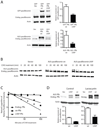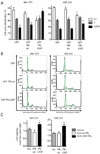Defective nucleolar localization and dominant interfering properties of a parafibromin L95P missense mutant causing the hyperparathyroidism-jaw tumor syndrome
- PMID: 20304979
- PMCID: PMC3098453
- DOI: 10.1677/ERC-09-0272
Defective nucleolar localization and dominant interfering properties of a parafibromin L95P missense mutant causing the hyperparathyroidism-jaw tumor syndrome
Abstract
The hyperparathyroidism-jaw tumor syndrome (HPT-JT) is a familial cancer syndrome that can result from germline inactivation of HRPT2/CDC73, a putative tumor suppressor gene that encodes parafibromin, a component of the transcriptional regulatory PAF1 complex with homology to the yeast protein Cdc73p. The vast majority of HRPT2/CDC73 germline mutations identified have been truncation or frameshift mutations, and loss of function due to missense mutation is rare. We report here a kindred with HPT-JT due to a germline L95P missense mutation in parafibromin. The mutant parafibromin was studied in vitro to understand the basis of its presumed loss-of-function. When transfected in cultured cells, the L95P mutant was expressed to a lower level than wild-type (wt) parafibromin, a difference that was not overcome by inhibition of the proteasomal degradation pathway. The L95P mutant parafibromin retained the ability to assemble with endogenous PAF1 complex components as evidenced by co-immunoprecipitation. Analysis of subcellular localization showed that the L95P mutant was markedly deficient in nucleolar localization compared to the wt, an impairment likely resulting from disruption of a putative nucleolar localization signal immediately upstream of the L95P mutation. Transfection of the L95P parafibromin mutant, but not the wt, enhanced cell cycle progression and increased cell survival in NIH-3T3 and HEK 293 cells, resulting apparently from dominant interference with endogenous parafibromin action. The simultaneous loss of nucleolar localization and acquisition of a growth stimulatory phenotype with the L95P mutation raise the possibility that parafibromin must interact with targets in the nucleolus to fully execute its tumor suppressor functions.
Conflict of interest statement
None of the authors has a conflict of interest that could be perceived as prejudicing the impartiality of the research reported herein.
Figures





Similar articles
-
Nuclear localization of the parafibromin tumor suppressor protein implicated in the hyperparathyroidism-jaw tumor syndrome enhances its proapoptotic function.Mol Cancer Res. 2007 Feb;5(2):183-93. doi: 10.1158/1541-7786.MCR-06-0129. Mol Cancer Res. 2007. PMID: 17314275
-
Characterization of a new CDC73 missense mutation that impairs Parafibromin expression and nucleolar localization.PLoS One. 2014 May 19;9(5):e97994. doi: 10.1371/journal.pone.0097994. eCollection 2014. PLoS One. 2014. PMID: 24842573 Free PMC article.
-
HRPT2, a tumor suppressor gene for hyperparathyroidism-jaw tumor syndrome.Horm Metab Res. 2005 Jun;37(6):380-3. doi: 10.1055/s-2005-870150. Horm Metab Res. 2005. PMID: 16001331 Review.
-
Characterization of a novel CDC73 gene mutation in a hyperparathyrodism-jaw tumor patient affected by parathyroid carcinoma in the absence of somatic loss of heterozygosity.Endocr J. 2019 Apr 25;66(4):319-327. doi: 10.1507/endocrj.EJ18-0387. Epub 2019 Feb 22. Endocr J. 2019. PMID: 30799315
-
Tumor suppressor gene mutation in a patient with a history of hyperparathyroidism-jaw tumor syndrome and healed generalized osteitis fibrosa cystica: a case report and genetic pathophysiology review.J Oral Maxillofac Surg. 2015 Jan;73(1):194.e1-9. doi: 10.1016/j.joms.2014.09.008. Epub 2014 Sep 28. J Oral Maxillofac Surg. 2015. PMID: 25511968 Review.
Cited by
-
Genomics and Epigenomics in Parathyroid Neoplasia: from Bench to Surgical Pathology Practice.Endocr Pathol. 2021 Mar;32(1):17-34. doi: 10.1007/s12022-020-09656-9. Epub 2020 Dec 2. Endocr Pathol. 2021. PMID: 33269427 Free PMC article. Review.
-
Hyperparathyroidism-jaw tumor syndrome: Results of operative management.Surgery. 2014 Dec;156(6):1315-24; discussion 1324-5. doi: 10.1016/j.surg.2014.08.004. Epub 2014 Oct 16. Surgery. 2014. PMID: 25444225 Free PMC article.
-
Identification and functional characterization of three NoLS (nucleolar localisation signals) mutations of the CDC73 gene.PLoS One. 2013 Dec 5;8(12):e82292. doi: 10.1371/journal.pone.0082292. eCollection 2013. PLoS One. 2013. PMID: 24340015 Free PMC article.
-
Clinical Features, Treatment, and Surveillance of Hyperparathyroidism-Jaw Tumor Syndrome: An Up-to-Date and Review of the Literature.Int J Endocrinol. 2019 Dec 18;2019:1761030. doi: 10.1155/2019/1761030. eCollection 2019. Int J Endocrinol. 2019. PMID: 31929790 Free PMC article. Review.
-
Insights into Hyperparathyroidism-Jaw Tumour Syndrome: From Endocrine Acumen to the Spectrum of CDC73 Gene and Parafibromin-Deficient Tumours.Int J Mol Sci. 2024 Feb 15;25(4):2301. doi: 10.3390/ijms25042301. Int J Mol Sci. 2024. PMID: 38396977 Free PMC article. Review.
References
-
- Bradley KJ, Cavaco BM, Bowl MR, Harding B, Cranston T, Fratter C, Besser GM, Conceicao Pereira M, Davie MW, Dudley N, et al. Parafibromin mutations in hereditary hyperparathyroidism syndromes and parathyroid tumours. Clin Endocrinol (Oxf) 2006;64:299–306. - PubMed
-
- Bradley KJ, Hobbs MR, Buley ID, Carpten JD, Cavaco BM, Fares JE, Laidler P, Manek S, Robbins CM, Salti IS, et al. Uterine tumours are a phenotypic manifestation of the hyperparathyroidism-jaw tumour syndrome. J Intern Med. 2005;257:18–26. - PubMed
-
- Carpten JD, Robbins CM, Villablanca A, Forsberg L, Presciuttini S, Bailey-Wilson J, Simonds WF, Gillanders EM, Kennedy AM, Chen JD, et al. HRPT2, encoding parafibromin, is mutated in hyperparathyroidism-jaw tumor syndrome. Nat Genet. 2002;32:676–680. - PubMed
-
- Cetani F, Pardi E, Borsari S, Viacava P, Dipollina G, Cianferotti L, Ambrogini E, Gazzerro E, Colussi G, Berti P, et al. Genetic analyses of the HRPT2 gene in primary hyperparathyroidism: germline and somatic mutations in familial and sporadic parathyroid tumors. J Clin. Endocrinol. Metab. 2004;89:5583–5591. - PubMed
Publication types
MeSH terms
Substances
Grants and funding
LinkOut - more resources
Full Text Sources
Miscellaneous

